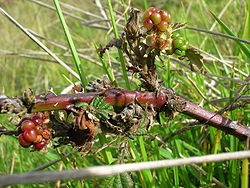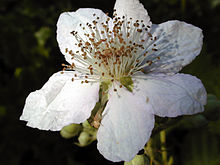- Rubus armeniacus
-
Rubus armeniacus
Zarza Himalayana
Tallo con fruto imaduroClasificación científica Reino: Plantae División: Magnoliophyta Clase: Magnoliopsida Orden: Rosales Familia: Rosaceae Género: Rubus Subgénero: Rubus Especie: R. armeniacus Nombre binomial Rubus armeniacus
FockeZarza Armeniana o Zarza Himalayana, syn. R. discolor Weihe & Nees nom. illeg., R. procerus auct. non P.J.Muell., es un especie de Rubus en la familia de las zarzas del grupo Rubus subgenus Rubus series Discolores (P.J. Müll.) Focke.
Es nativa al Armenia y el sudoeste de Asia con distribución amplia en el resto del mundo.
Contenido
Descripción
Rubus armeniacus is a perennial plant which bears biennial stems ("canes") from the perennial root system. In its first year, a new stem grows vigorously to its full length of 4-10 m, trailing along the ground or arching up to 4 m high, stout, up to 2–3 cm diameter at the base, and green, or reddish-tinged above if open to bright sun. The leaves on first year shoots are 7–20 cm long, palmately compound with five leaflets; flowers are not produced on first year shoots. In its second year, the stem does not grow longer, but produces several side shoots, which bear smaller leaves with three leaflets (rarely a single leaflet); the leaflets are oval-acute, dark green above and pale to whitish below, with a toothed margin, and thorns along the midrib on the underside. The flowers are produced in late spring and early summer on panicles of 3–20 together on the tips of the second-year side shoots, each flower 2–2.5 cm diameter with five white or pale pink petals.
The fruit, in botanical terminology, is not a berry, but an aggregate fruit of numerous drupelets, 1.2–2 cm diameter, ripening black or dark purple. Both first and second year shoots are spiny, with short, stout, curved, sharp spines. Mature plants form a tangle of dense arching stems, the branches rooting from the node tip when they reach the ground.[1]
Cultivo
Baya hortalizada
La especie fue introducida a Europa en 1835 y a Australasia y América del Norte en 1885. Fue valorado por ser similitúd a las zarzamoras comunes pero con un mayor tamaño y gusto más dulce. Éste aspecto la hizo ideal para producción commercial asicomo cultivo domestico. Los cultivares con mayor uso son las variedades "gigante himalayano" y "Theodore Reimers".
Invasiva
Rubus armeniacus ha escapado de las areas de cultivo y se ha convertido en una especie invasiva muy seria a través del mundo de clima temperado.[2] [3]
Fuentes
Enlaces externos
 Wikimedia Commons alberga contenido multimedia sobre Rubus armeniacus. Commons
Wikimedia Commons alberga contenido multimedia sobre Rubus armeniacus. Commons
Categorías:- Wikipedia:Wikificar botánica
- Rubus
- Flora de Armenia
- Flora de Asia
- Plantas alóctonas invasoras de España
- Berries
- Invasive plant species
- Invasive plant species in the United States
- Invasive plant species in California
- Invasive plant species in Australia
Wikimedia foundation. 2010.

